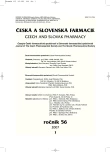Analysis of supplying situation in pharmacies I. Supply with medicaments and health appliances from the viewpoint of pharmacies and distributors
Analýza zásobovací situace v lékárnách I. Zásobování léčivy a zdravotnickými prostředky z pohledu lékáren a distributora
Práce popisuje v současnosti používané způsoby objednávání, jejich časovou náročnost, klady a zápory. Výsledky rozboru dat z lékáren byly porovnány s údaji zjištěnými analýzou dat poskytnutých distributorem. Metodika práce zahrnuje: dotazníkový průzkum, metodu autosnímku a rozbor archivních dat z lékáren a od distributora. Nejčastější odpovědí na počet dodávajících velkodistributorů je 2 (38,1 % lékáren) a 3 (33,3 % lékáren), lékárny od nich nejčastěji odebírají 3x denně (28,1 % lékáren). K sestavení objednávky přistupuje 61,9 % lékáren intuitivně, 38,1 % využívá možnosti automatického návrhu objednávky PC systémem. 66,6 % lékáren využívá modemového objednávání, výhodami jsou rychlost (49,3 %), časová dostupnost (41,2 %), přehled o potvrzených přípravcích (28,5 %) a finanční zvýhodnění (23,8 %). Průměrný čas objednávání činí 21 minut denně pro telefonické objednávky a 4 minuty denně pro modemové objednávky, průměrný podíl ve využití jednotlivých způsobů objednávání je 59,1 % : 40,9 % položek ve prospěch modemových objednávek. Na případu konkrétní lékárny je ukázán dopad změn vyplývajících z přechodu z objednávání výhradně telefonického na objednávání převážně pomocí modemu, časová úspora činila 62,5 % (ze 14,4 s na 5,4 s na l objednávanou položku). Z rozboru dat od distributora vyplývá nárůst podílu položek i balení objednávaných modemem (z 22,2 %, resp. 20,6 % v roce 2000 na 54,5 % resp. 49,8 % v roce 2004).
Klíčová slova:
lékárna – objednávání léčiv – distribuce léčiv
Authors:
B. Macešková; J. Vyhnalíková 1
Authors‘ workplace:
Verinární a farmaceutická univerzita Brno, Ústav aplikované farmacie
; Lékárna U lva, Mikulov
1
Published in:
Čes. slov. Farm., 2007; 56, 42-45
Category:
Original Articles
Overview
The paper describes the contemporary methods of ordering, their demands for time, and positive and negative aspects. The results of the analysis of the data from pharmacies were compared with the data found by analyzing the data provided by the distributor. The methodology of the paper includes: a questionnaire survey, the method of the autopicture, and an analysis of archival data from pharmacies and distributors. The most frequent response to the question concerning the number of supplying wholesale distributors is two (38.1 % of pharmacies) and three (33.3 % of pharmacies); pharmacies receive supplies from them most frequently three times a day (28.1 % of pharmacies). 61.9 % of pharmacies compile the orders intuitively, 38.1 % of them use the possibilities of the automatic proposal of the order using a PC system. 66.6 % of pharmacies utilize modem ordering whose advantages are rapidity (493 %), time availability (41.2 %), a list of confirmed preparations (28.5 %), and financial advantageousness (23.8 %). The average time of ordering amounts to 21 min a day for telephone orders and 4 min a day for modem orders, the average proportion in the use of the individual methods of ordering is 59.1 % to 40.9 % of items to the benefit of modem orders. A concrete pharmacy was selected to demonstrate the effect of changes resulting from the transition from exclusively telephonic ordering to prevalently modem ordering; saved time period amounted to 62.5 % (from 14.4 s to 5.4 s per l ordered item). The analysis of distributors’ data reveals an increase in the share of the items and packages ordered via modem (from 22.2 %, and 20.6 %, respectively, in the year 2000, to 54.5 % and 49.8 %, respectively, in the year 2004).
Key words:
pharmacy – drug ordering – drug distribution
Labels
Pharmacy Clinical pharmacologyArticle was published in
Czech and Slovak Pharmacy

2007 Issue 1
Most read in this issue
- Extrusion/spheronization: an important method for the production of the pellet dosage form
- The influence of the extrusion die on pellet characteristics
- Deep vein thromboembolism in malignant diseases
- Constituents of Lilium candidum L. and their antioxidative activity
